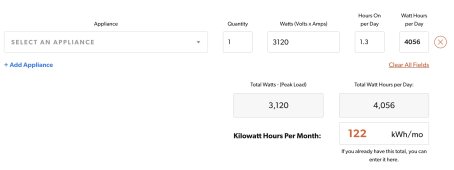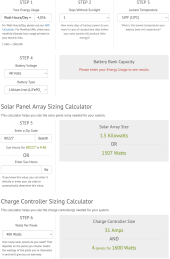Hello everyone!
Total noob here looking for some guidance. Here’s my shot at brevity with specs, context, and use cases.
Use Case: Charge my electric dirtbike on multi-day trips…as well as my drone batteries.
I can buy 2 Ecoflow Delta Pros ($7500) and daisy chain them together with their 240 adapter and accomplish what I’m after (I think) but I am interested in a cheaper DIY option.
Bike Battery Specs:
Rated voltage: 259.2 V
Rated energy: 3.888 kWh
Rated capacity: 15 Ah
Max. charging current: 10A
Bike Battery Charger Specs:
AC INPUT: 220-240V ~, 50/60Hz, 13A Max.
DC HV OUTPUT: 180 - 302.4V ==-, 10.0A Max.
DC LV OUTPUT: 14.5V ==-, 4.0A Max.
Charger plug: it came with a male L6-20. I purchased a NEMA 14-30P Male to L6-20R Female, 20A, 250V adapter so I could plug it into my dryer outlet to charge my bike at home. Thanks to these guys here! chargethebike.com
Potential set up…
Solar Inverter: EG4 6000EX-48HV 6000W Output 7500W PV Input Split 500V VOC Input Split Phase 120/240VAC
Battery: EG4 LifePower4 Lithium Battery 48v 100AH Server Rack Battery 5.12kWh
Portable Solar Panels: Could use help here
Cables: Also some help here
Outlets: (I’m not looking to use 120 and 240 at the same time)
1 to charge bike
2 regular 3 prong wall outlet (1 for drone, 1 for misc)
2 usb-c for general glamping
Maybe there is something else I need?
My thinking is after I recharge my bike once, that will leave me with 1.24kWh hours in the EG4 Battery. Then I will solar charge on day 2 back up to at least 3.9kWh so that I can recharge my bike again in order to get 2 full recharges on 3 day trips. (Rinse and repeat for longer trips).
Although the bike is 100% the priority, I figured if I’m building this I might as well aim for something multipurpose to charge my drone and other misc items.
Last but not least, it looks like mounting this to a hand truck like this is the way to go. Although I don’t know if it’s possible to make it a little more weatherproof since the inverters I believe are supposed to be used indoors only.
Any insights is much appreciated!
Total noob here looking for some guidance. Here’s my shot at brevity with specs, context, and use cases.
Use Case: Charge my electric dirtbike on multi-day trips…as well as my drone batteries.
I can buy 2 Ecoflow Delta Pros ($7500) and daisy chain them together with their 240 adapter and accomplish what I’m after (I think) but I am interested in a cheaper DIY option.
Bike Battery Specs:
Rated voltage: 259.2 V
Rated energy: 3.888 kWh
Rated capacity: 15 Ah
Max. charging current: 10A
Bike Battery Charger Specs:
AC INPUT: 220-240V ~, 50/60Hz, 13A Max.
DC HV OUTPUT: 180 - 302.4V ==-, 10.0A Max.
DC LV OUTPUT: 14.5V ==-, 4.0A Max.
Charger plug: it came with a male L6-20. I purchased a NEMA 14-30P Male to L6-20R Female, 20A, 250V adapter so I could plug it into my dryer outlet to charge my bike at home. Thanks to these guys here! chargethebike.com
Potential set up…
Solar Inverter: EG4 6000EX-48HV 6000W Output 7500W PV Input Split 500V VOC Input Split Phase 120/240VAC
Battery: EG4 LifePower4 Lithium Battery 48v 100AH Server Rack Battery 5.12kWh
Portable Solar Panels: Could use help here
Cables: Also some help here
Outlets: (I’m not looking to use 120 and 240 at the same time)
1 to charge bike
2 regular 3 prong wall outlet (1 for drone, 1 for misc)
2 usb-c for general glamping
Maybe there is something else I need?
My thinking is after I recharge my bike once, that will leave me with 1.24kWh hours in the EG4 Battery. Then I will solar charge on day 2 back up to at least 3.9kWh so that I can recharge my bike again in order to get 2 full recharges on 3 day trips. (Rinse and repeat for longer trips).
Although the bike is 100% the priority, I figured if I’m building this I might as well aim for something multipurpose to charge my drone and other misc items.
Last but not least, it looks like mounting this to a hand truck like this is the way to go. Although I don’t know if it’s possible to make it a little more weatherproof since the inverters I believe are supposed to be used indoors only.
Any insights is much appreciated!




